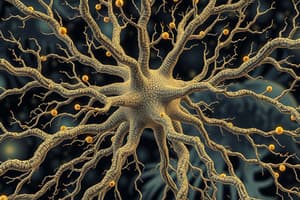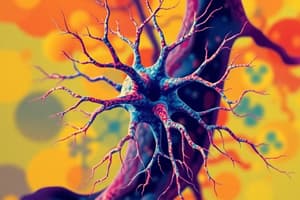Podcast
Questions and Answers
What is the main function of dendrites in a neuron?
What is the main function of dendrites in a neuron?
- Increase the surface area of the cell body. (correct)
- Insulate the axon for faster signal transmission.
- Conduct nerve impulses away from the cell body.
- Store neurotransmitters for synaptic release.
Which part of the neuron is responsible for conducting the nerve impulse away from the cell body?
Which part of the neuron is responsible for conducting the nerve impulse away from the cell body?
- Axon (correct)
- Nissel bodies
- Cell body
- Dendrites
What is the role of the myelin sheath in nerve fibers?
What is the role of the myelin sheath in nerve fibers?
- To increase the volume of axonal transmission.
- To act as an electric insulator. (correct)
- To facilitate the production of neurotransmitters.
- To provide structural support to the neuron.
What type of nerve fibers are characterized as non-myelinated with a conduction velocity of approximately 1 m/s?
What type of nerve fibers are characterized as non-myelinated with a conduction velocity of approximately 1 m/s?
Which structure is absent from the neurons of the central nervous system (CNS)?
Which structure is absent from the neurons of the central nervous system (CNS)?
What is the effect of the rate of application of a stimulus on the response?
What is the effect of the rate of application of a stimulus on the response?
What does the term Rheobase refer to?
What does the term Rheobase refer to?
What is the significance of Chronaxie in physiological response?
What is the significance of Chronaxie in physiological response?
Which factor does NOT affect the degree of response to a stimulus?
Which factor does NOT affect the degree of response to a stimulus?
In the context of electrical stimuli, what is Minimal Duration (t)?
In the context of electrical stimuli, what is Minimal Duration (t)?
Flashcards
Neuron
Neuron
The basic structural unit of the nervous system.
Cell Body (Soma)
Cell Body (Soma)
The central part of a neuron containing the nucleus and other organelles.
Dendrites
Dendrites
Short, branching processes that receive signals from other neurons.
Axon
Axon
Signup and view all the flashcards
Axon Hillock
Axon Hillock
Signup and view all the flashcards
Myelin Sheath
Myelin Sheath
Signup and view all the flashcards
Nodes of Ranvier
Nodes of Ranvier
Signup and view all the flashcards
Neurilemma (Schwann Sheath)
Neurilemma (Schwann Sheath)
Signup and view all the flashcards
Excitability
Excitability
Signup and view all the flashcards
Neurofibrils
Neurofibrils
Signup and view all the flashcards
Nissl Bodies
Nissl Bodies
Signup and view all the flashcards
Stimulus
Stimulus
Signup and view all the flashcards
Types of Stimuli
Types of Stimuli
Signup and view all the flashcards
Electrical Stimulus
Electrical Stimulus
Signup and view all the flashcards
Rheobase
Rheobase
Signup and view all the flashcards
Utilization Time (UT)
Utilization Time (UT)
Signup and view all the flashcards
Chronaxie
Chronaxie
Signup and view all the flashcards
Strength-Duration Curve (SD Curve)
Strength-Duration Curve (SD Curve)
Signup and view all the flashcards
Excitability
Excitability
Signup and view all the flashcards
Minimal Duration (t)
Minimal Duration (t)
Signup and view all the flashcards
Diathermy
Diathermy
Signup and view all the flashcards
Electrocautery
Electrocautery
Signup and view all the flashcards
Study Notes
Physiology of the Nerve (Lecture 1)
- The nerve cell (neuron) is the structural unit of the nervous system.
- A neuron is composed of two main parts: the cell body (soma) and the cell processes.
The Cell Body (Soma)
- Contains a large central nucleus with a nucleolus.
- Cytoplasm includes neurofibrils (delicate strands), Nissl bodies (large triangular masses high in RNA), and other organelles like the Golgi apparatus and endoplasmic reticulum.
- The neuron lacks a centrosome and cannot divide.
The Cell Processes
- Two types: dendrites and axons.
Dendrites
- Short, branching processes extending from the cell body.
- Increase the surface area of the cell body (receptive field).
- Conduct nerve impulses towards the cell body.
Axon
- A single, long process originating from the axon hillock (thickened area of the cell body).
- Conducts nerve impulses away from the cell body and dendritic zone.
- Ends in terminal buttons (axon telodendria) containing neurotransmitters (e.g., acetylcholine).
- Axons are also called nerve fibers.
Nerve Fiber Covering
- The axon is covered by a myelin sheath, a protein-lipid complex acting as an electrical insulator.
- The myelin sheath is interrupted at nodes of Ranvier.
- An outer layer called the neurilemmal sheath (or Schwann sheath) surrounds the myelin sheath. It regenerates the nerve fiber if it's cut. (The CNS lacks this layer, using oligodendrocytes instead.)
- Axons are classified according to the presence of myelin: A (thick myelinated), B (thin myelinated), and C (non-myelinated).
- Conduction speeds vary: A fibers have high speed (around 100m/s), followed by B (around 10 m/s), and then C (around 1 m/s).
Excitability
- The ability of living tissue to respond to a stimulus.
- Nerve tissue is highly excitable.
- A stimulus is any change in the environment causing a tissue to react (e.g., electrical, chemical, mechanical).
Factors Affecting Stimulus Response
-
The rate of stimulus application.
-
The strength of the stimulus.
-
The duration of the stimulus.
-
A strong, sudden stimulus is more effective than a weak, gradual one.
Strength-Duration Curve
- Illustrates the relationship between stimulus strength and duration required to elicit a response.
- Key factors: rheobase (minimum intensity for stimulation), chronaxie (time needed for a stimulus twice the intensity of the rheobase to evoke a response), and utilization time (time a stimulus takes, starting at the rheobase).
- The greater the excitability, the shorter the chronaxie. Excitability varies between different tissues (e.g. nerve > skeletal muscle > cardiac muscle).
Cathode Ray Oscilloscope (CRO)
- Used to record electrical activity of neurons.
- Measures rapid events in milliseconds and millivolts.
- Utilizes microelectrodes (fine glass pipettes) filled with KCl as electrical conductors.
Resting Membrane Potential (RMP)
- Potential difference between the inner and outer sides of the membrane at rest.
- Typically, -70 mV (negative inside).
- Caused by selective membrane permeability (more permeable to K+ than Na+) and the Na⁺-K⁺ pump, which actively transports Na⁺ outwards and K⁺ inwards.
Selective Permeability of the Membrane
- The resting membrane is more permeable to K+ than Na+ (about 50-100 times).
- K+ channels are open at rest and there are factors like hydration energy which further explain this permeability.
The Na⁺-K⁺ Pump
- An active transport mechanism.
- Pumps 3 Na+ ions out and 2 K+ ions in, maintaining the concentration gradient and membrane potential.
- Inhibited by low temperature or a drug like ouabain.
Studying That Suits You
Use AI to generate personalized quizzes and flashcards to suit your learning preferences.




